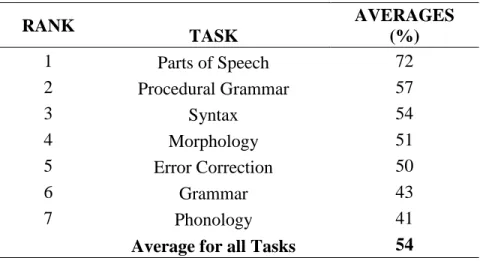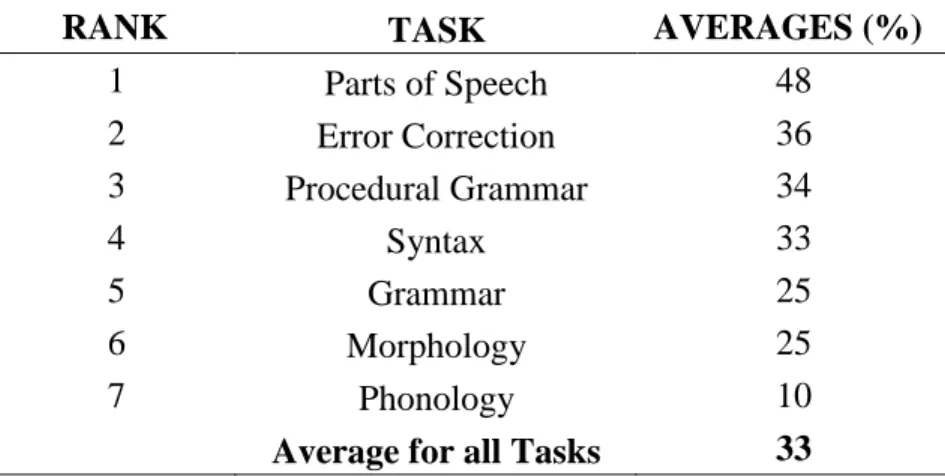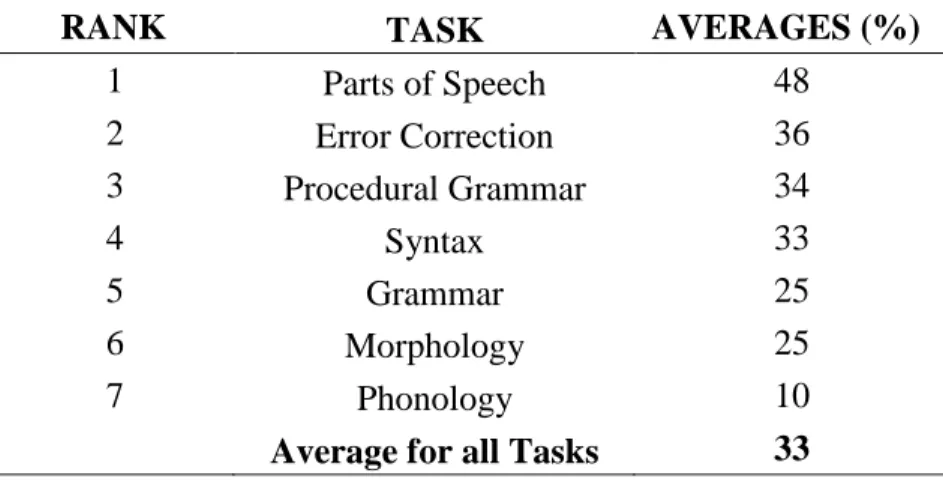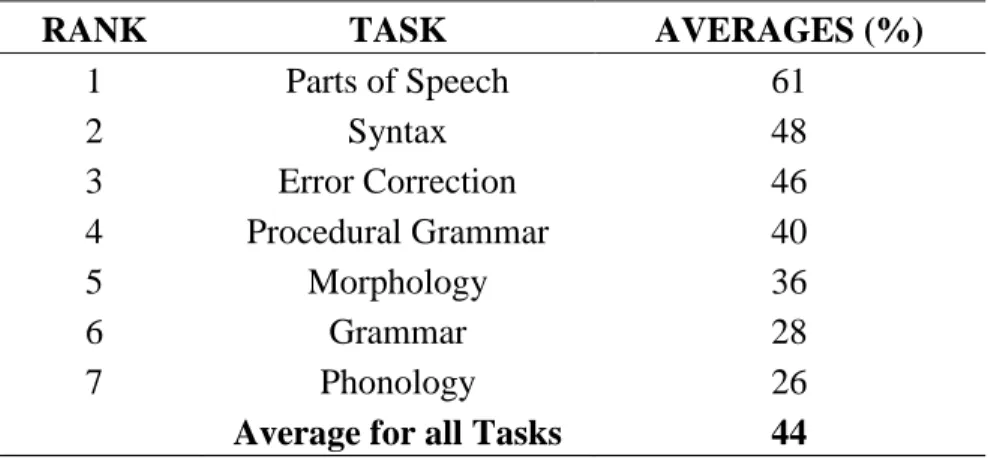The findings replicated findings from previous research that TBL teachers demonstrated greater metalinguistic and register awareness than NTBL teachers. The study further confirmed that NES teachers have greater metalinguistic and register awareness than their NES counterparts.
Introduction Introduction
Definitions of Terms
Explicit knowledge of language is defined as the declarative, conscious knowledge of features of the L2 that can be learned and possibly verbalized. Implicit knowledge of the L2 is often defined as the intuitive and procedural knowledge that is normally acquired automatically in fluent performance and that cannot be verbalized (Gutiérrez, 2012, p. 21).
Rationale and Significance
The extent to which a person has access to and command of the oral and written academic records of schooling” (Cummins, 2000, p. 67). In this regard, the study compares NES and NNES teachers in terms of the metalinguistic and register awareness that they possess.
Problem Statement and Research Questions
Whether and to what extent oral proficiency in a non-English language promotes NES teachers' metalinguistic and register awareness of English. Whether and to what extent oral proficiency in a non-English language promotes NNES teachers' metalinguistic and register awareness of English.
Domains and Theoretical Frameworks
It is worth adding that knowledge of parts of speech is not necessarily the only criterion for effective teaching; teachers must have pedagogical skills. Andrews (2003) argues that teachers need to combine both explanatory and procedural aspects of language teaching for effective teaching.
Significance of the Study
This PhD study aims to assess teachers' awareness of register by creating an instrument that assesses teachers' awareness of academics vs.
Limitations of the Study
In particular, register awareness in SLA research has hardly been addressed, particularly in terms of its relevance to teachers. The purpose of the study was to examine whether and to what extent non-literacy non-English language skills promoted metalinguistic and register awareness in English regardless of geographic location.
Organization of the Thesis
Literature Review
Background to Literature Review
A further and very crucial consideration in the discussion herein is the relevance of what registry refers to and its contribution to our understanding of academic language use. It should be emphasized that this thesis is not intended to place colloquial language in a subordinate position compared to academic language or any other formal language register.
Review of Relevant Theories and Hypotheses
- Constructs of Cognition
- Constructs of Learning
- Metacognitive Approaches to Language
- Structure in second language acquisition
- Language Proficiency and Literacy
- Teacher Profiles
- Discourse Analysis
As argued above, a teacher's metalinguistic awareness is essentially centered on a thorough knowledge of the subject matter of the language, which implies that he has competence in linguistic content. Bigelow and Tarone (2005) argue that this occurs in the process of the acquisition of reading skills in the L2. The structure of the subjunctive mood becomes even more complicated when it is used in the passive voice.
Regarding the discussion of the term “input”, there is no unified definition of input in the SLA literature (Chi, 2016). Renou (2001) defines metalinguistic awareness as the conscious knowledge of the formal elements of the target language. In this sense, the use of the term metalinguistic awareness defines the ability of a teacher to reflect on his explicit knowledge about language.
Andrews argues (2003, p. 82) that "knowledge of subject matter constitutes the core of a teacher's language awareness," which is usually defined as the teacher's knowledge of the language systems. Gordon emphasizes that without knowledge of the structure of language, teachers will not be able to contribute to their students' language. For this purpose, the complex role of the knowledge of orthography must be brought forward.
Summary
This chapter begins by providing a summary of the aim and objectives of the study, followed by a detailed analysis of the research design and the justification for choosing a qualitative research design. Following the discussion about the research design used in this study, the participants will be introduced. This is followed by an analysis of the instrument and of the specific tasks that the participants had to complete in the instrument.
Relevant tables regarding the linguistic and academic background of the participants are provided, which is followed by an overview of the assessment process of the participants' metalinguistic and register awareness.
Aim and Objectives
Research Design
In particular, the instrument sought to assess teachers' metalinguistics and record awareness in terms of the language subskills listed above. In the light of the previous discussion, it would be wrong to label the tasks in the instrument as 'artificial'. In other words, literacy skills do not usually receive much attention in the discussion of the construct of bilingualism.
A good example comes from one of the participants who is a native English speaker. City and from the institutions to which the participants were affiliated at the time of the survey. The components of the instrument aim to obtain data regarding the following critical areas: structure (error analysis), grammar (involving pedagogical intervention).
An important aspect of this part of the instrument is that the instructions for. The plural suffix of the word cat (cats) is pronounced /s/, and the plural suffix of the word dog (psi) is /z/. The last item in this part of the instrument (item 11) asked participants to distinguish between a phrase and a.
What made the landing difficult was severe weather conditions
- Summary
For example, apostrophe followed by –s in English is challenging not only for students but also for teachers. He believes that ('er) in the sentence "Ali's a car" represents has (the sentence is not meaningful!). The assessment of this section will be subjective, as is the case with the other parts of the instrument.
For the first sentence, if the participants could explain that the word swim is a present participle and that it serves as the main verb of the sentence, he will get a full mark. In the second sentence, the participant could also get a full mark if he could state that swimming is a gerund and functions as the subject of the sentence. Scoring, the most important component of the assessment of teachers' metalinguistic awareness was expanded, which was.
The next section, Chapter 4, presents a detailed analysis of the results and an in-depth discussion of whether participants' metalinguistic awareness is associated with the variables discussed in Chapter 3.
Findings Findings
The Structure of Chapter 4
This chapter presents the participants' results in tables and briefly explains the rationale behind each table design. In addition, a discussion of how the relevant tables contribute to the analysis and interpretation of the participants' results is included. It should be noted that since a considerable number of tables represent the findings, detailed and comprehensive tables can be referred to in the appendices section (pages 321-489), while those tables presenting a summary of the findings can be found in Chapter 4.
These summary versions of the tables provide the essential data for the reader to review in a concise yet comprehensive manner.
Tables
As pointed out above, the tables shown in this chapter represent a summary of all the tables in Appendices A, B and C; the scores of the individual teachers are not reflected. The first five categories reflect the average score for each participant category; All participants, true bilingual participants, non-true participants, English speaking and non-English speaking participants. These five tables rank participants based on their average scores depending on which task categories they were most successful in.
The sixth table provides a summary of all the tables; it displays the average scores for all the participant categories based on their performance in each task category; Error correction, grammar, phonology, syntax, morphology, parts of speech and procedural grammar respectively. The seventh and the final table provide a very basic summary; it only displays the averages of the participant categories. To summarize, the tables that provide more comprehensive data on the findings are in the Appendices section, while the tables displayed below provide a summary of the tables in Appendices A, B and C.
Analysis of Responses
The average for all participants was 51% for procedural grammar, while it was only 38%. In addition, it displays the overall average of all tasks for each teacher, along with the scores and corresponding averages obtained by all other truly bilingual teachers. As shown in Table C2 in Appendix C and in Table 7 below, the mean score of the truly bilingual participants was not only above the overall mean of all participants.
In other words, it displays averages based only on the performance of all participants in all task categories. Additionally, it displays the total averages of all assignments for each NTBL teacher, along with the corresponding scores and averages obtained by all NTBL teachers. Findings suggest that NNES participants performed as successfully as TBL participants on all tasks.
Summary of participant categories in terms of the overall averages across all tasks.

Tasks 49 Average for all
Tasks 54 Average for all
Tasks 33 Average for all
Tasks 44 Average for all
Yes I did." As is the case with other tasks, some of the participants' responses function as model responses. This is the case with other tasks, some of the participants' responses function as model responses. For example, in the first item of the error correction task, a teacher uses the metalanguage items.
In this part of the findings, the participants' responses to the statement, Thank you for inviting us to your home, are quoted and followed by a discussion. As in the case with item 1, some of the participants' responses are quoted as a model response to item 2. Eighteen of 23 participants (both native and non-native) were apparently unaware of the inversion rule.
Comparing TBL and NTBL participants' answers to sentence 4 gave a different picture of teachers' metalinguistic awareness.


